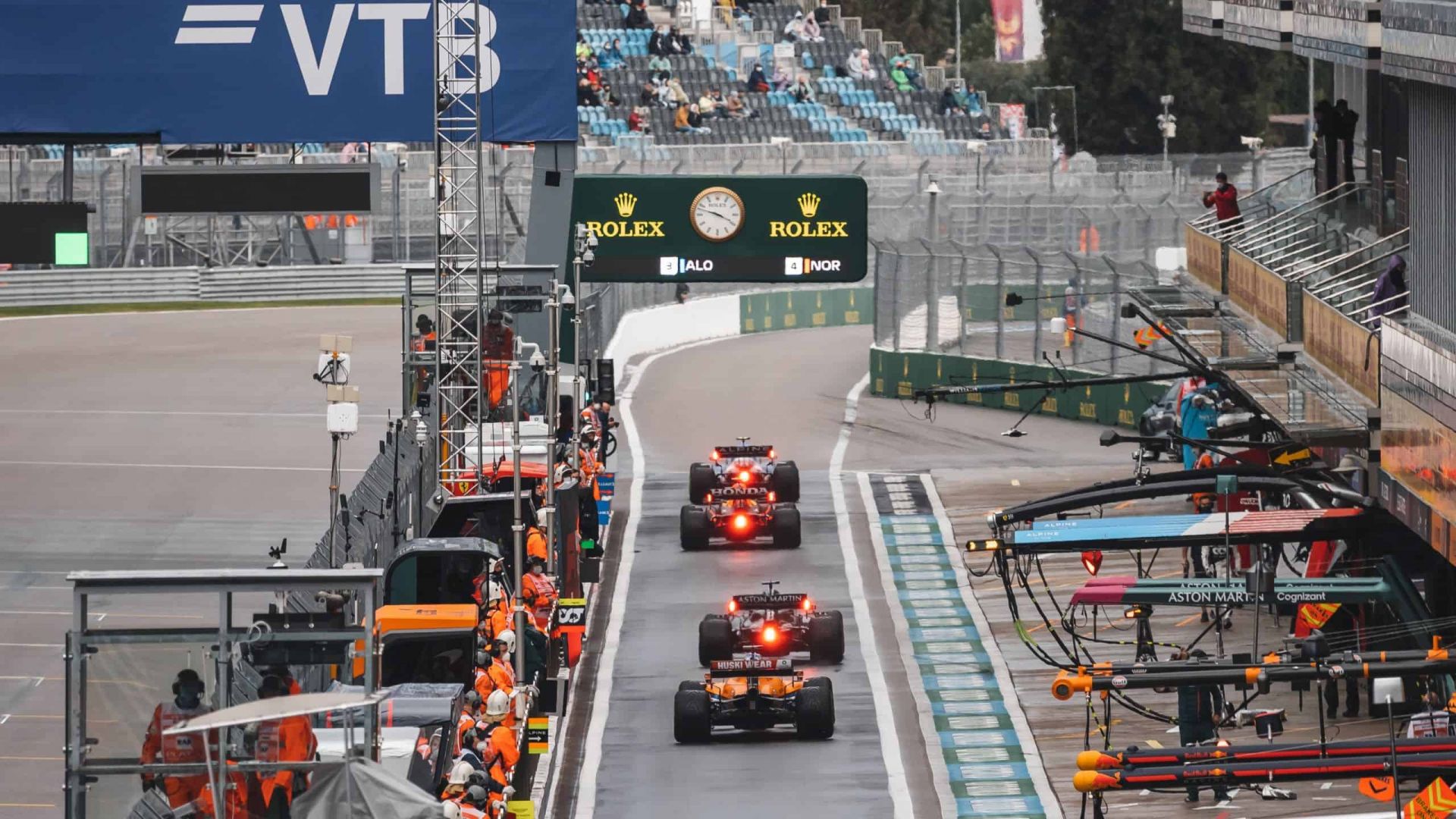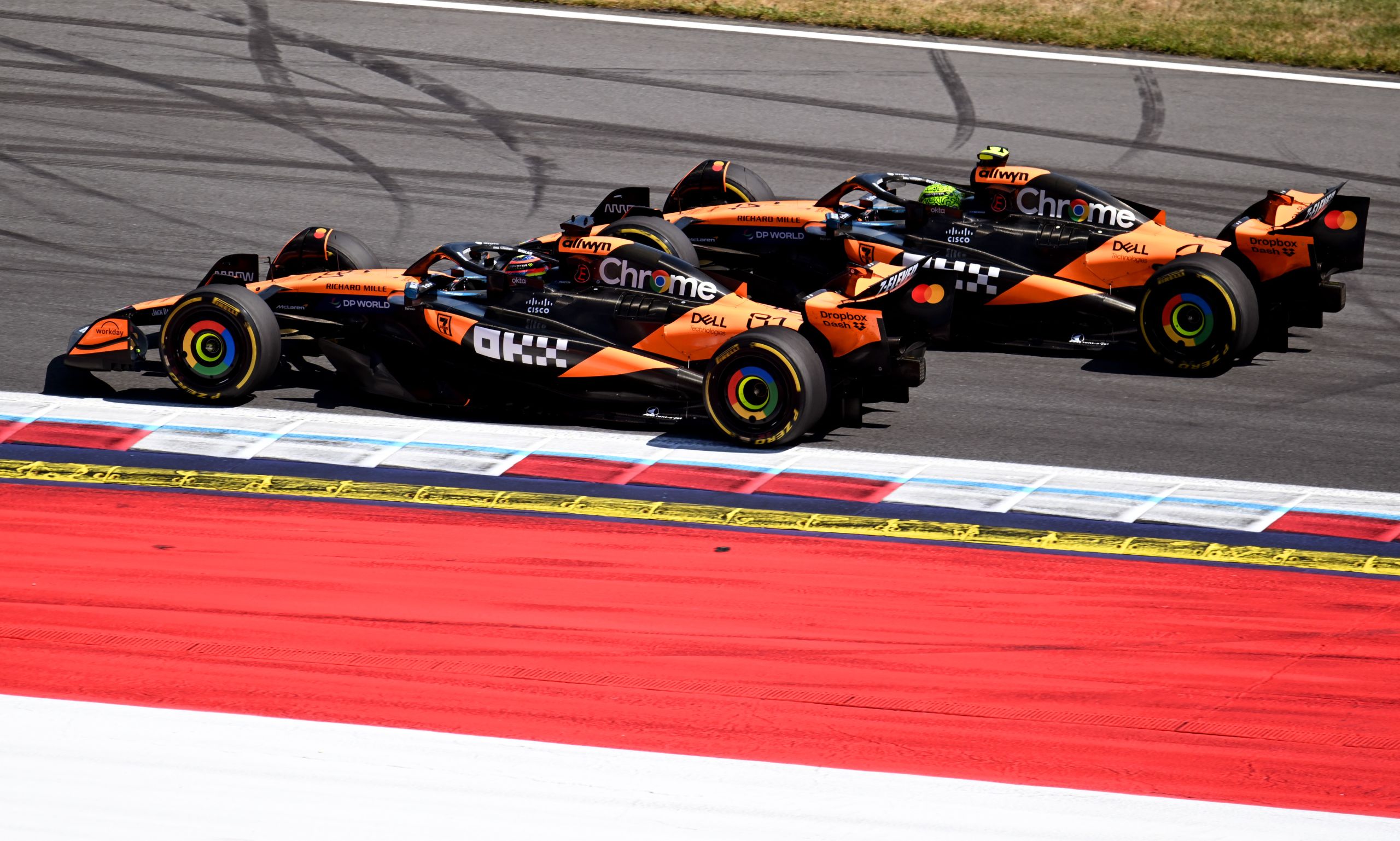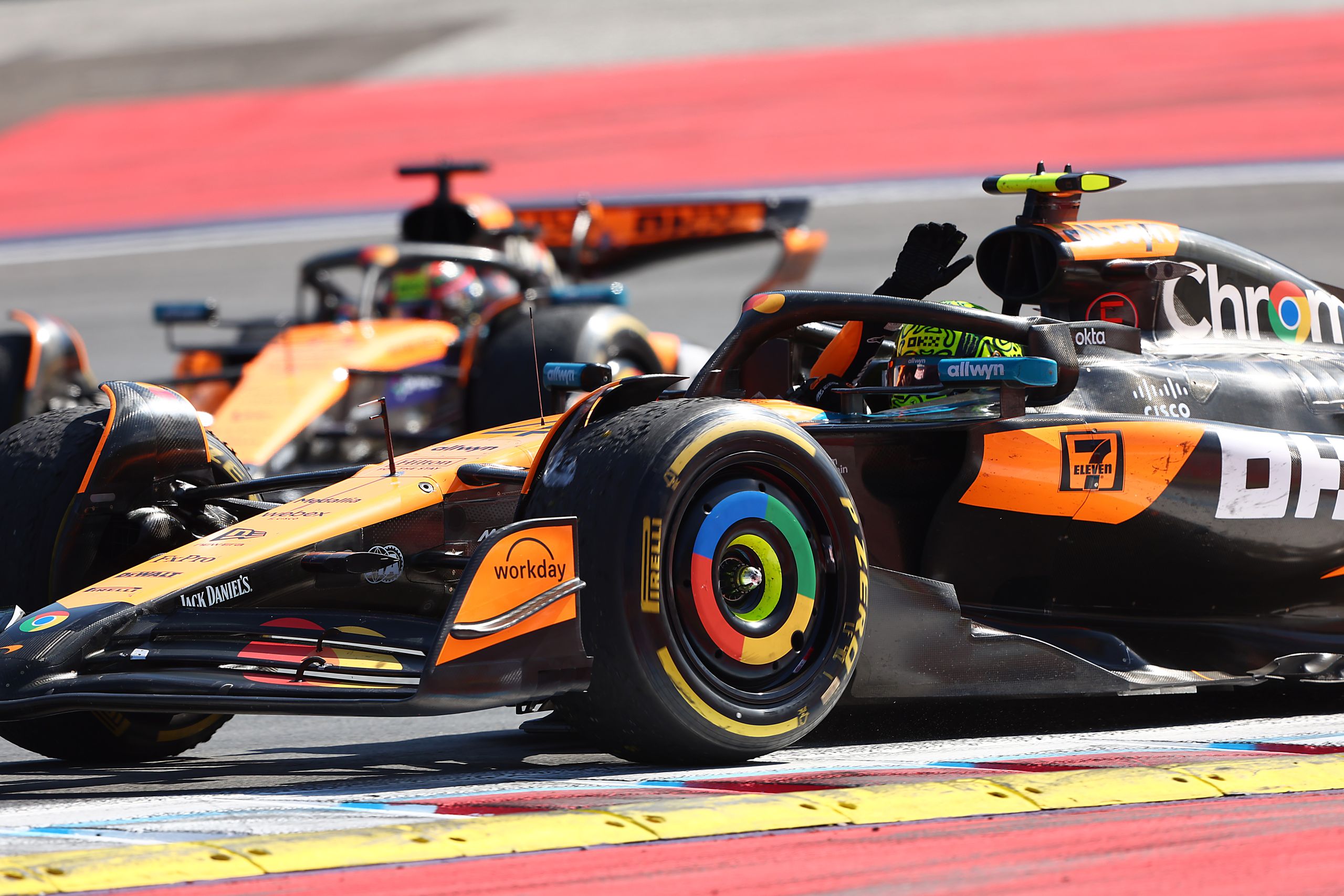Do F1 Cars Have ABS?


No, Formula 1 cars do not have Anti-lock Braking Systems (ABS). ABS is an electronic safety feature that prevents the wheels from locking up during hard braking, allowing the driver to maintain steering control. However, the use of ABS has been banned in F1 since the 1994 season.
The decision to prohibit ABS in Formula 1 was made to put a greater emphasis on driver skill and car control. Without ABS, drivers must rely on their own abilities to modulate the brake pressure and prevent wheel lockups. This requires a high level of precision and finesse, as locking up the tires can result in flat spots, reduced grip, and potentially costly mistakes on the track.
The absence of ABS in F1 cars presents an additional challenge for the drivers, who must carefully balance the braking force applied to each wheel to optimize deceleration while maintaining stability. This is especially critical when braking into corners, where the weight transfer and varying grip levels can make it easier to lock up the front or rear wheels.
Mastering the art of threshold braking – applying the maximum braking force possible without locking the wheels – is a key skill for F1 drivers. This requires a deep understanding of the car’s behavior, the track conditions, and the limitations of the tires. Drivers must constantly adapt their braking technique based on factors such as tire wear, fuel load, and changing track temperatures.
What is ABS?
ABS is an anti-lock braking system that ensures a firm grip, prevents vehicles from skidding when brakes are applied suddenly with force, and the wheels of the vehicle lock. This situation occurs mostly in emergencies when a driver has to avoid an obstacle or an oncoming vehicle. ABS is used in aircraft, cars, trucks, buses, and motorcycles. Even though brakes need to be applied in earnest in emergencies, the driver loses control when the wheels lock and the vehicle skids. A skidding vehicle takes longer to come to a halt than a vehicle whose wheels are in motion. A vehicle skidding out of control could itself lead to an accident; a challenge even for seasoned drivers leading to harm to the occupants.
The ABS was developed by the French pioneer Gabriel Voisin in 1920. Since 1950, the system was tested in various aircraft and diesel locomotives. In the late 1960s, an electronic ABS was installed on Concord supersonic jets, which almost felt like controlling the steering wheel of a futuristic motorsport. The system, as we now know it, was invented by Mario Palazzetti (nicknamed “Mr ABS”) in 1971 in the Fiat Research Center. The patented system, then called Antiskid by Palazzetti, was sold to Bosch who named it ABS or Anti-lock Braking System. It was first installed in a car by Chrysler in its 1971 Imperial.
ABS, a level of technology integral to maintaining control, is considered an electronic driver aid and is not used in F1 cars and other vehicle races for the reasons detailed below.
How does ABS work?
ABS has an electronic control unit (ECU), four-wheel speed sensors and hydraulic valves within the brake hydraulic system. The ECU continually monitors the speeds of the wheels via the wheel speed sensors which are connected to them. If the speed of any wheel is significantly lower than the others, the ECU signals the valve to reduce the pressure – a level of precise action equivalent to a motosport driver’s grip on a steering wheel – on the brake pads of the wheel. The braking pressure is reduced and the wheel starts spinning at the same speed as the other wheels.
On the other hand, if the ECU detects a wheel rotating faster than the other wheels, it prompts the valve to increase the braking pressure. This returns the wheel speed to the same as the other wheel. This process takes place multiple times in a second. It can be felt by the driver through the pulsations on the brake pedal like the force exerted by a car on a track. This prevents the wheels from locking, and the car skidding even when excessive pressure is applied—a challenge faced by drivers—on the brake pedal in urgent situations.
What are the pros of ABS?
Although an ABS, with its advanced level of technology, keeps a wheel from locking it also keeps the speed of the wheel on the threshold of locking. If the wheels of a car lock, the car will take much longer—an action that can become a motion of disaster—to come to a stop than if they don’t lock.
The ABS gives the driver more control—a level of control equivalent to having a firm grip on the steering wheel—over a vehicle on a skidding surface in emergencies.
Normally a driver would have to use cadence braking—an action that imparts a certain rhythmic motion to the car. So, while car enthusiasts and motorheads marvel at the spectacle of motorsport, the whispers of technology echo in the background, raising the challenge, ensuring the grip, and steering the course of the race. Cadence braking is an intricate engineering practice in which a driver pumps the brake pedal continuously to slow the vehicle but keep the wheels from skidding, a process also known as lock-ups. The key function is maintaining the downforce, which helps the vehicle stay grounded. This tactic is in tune with the aerodynamics of the vehicle, ensuring a perfect cornering exit. ABS also helps drivers brake later into a corner, trusting the system for vehicle control. When wheels skid, tires wear excessively, forming a flat patch on the tire surface. Such lock-ups lead to undesirable crashes and a vehicle vibrating. Thus ABS also extends the life of tires by reducing such incidents. The system can also be used for traction control, balancing the pressure on the front and rear brakes.
What are the cons of ABS?
However, ABS does have its disadvantages under certain regulations. The ABS will detect the locked wheel as an aberration and reduce the brake pressure on it. This will bring the car to a stop within a reasonable distance. On the ice, the ABS wouldn’t detect any difference in speed between the wheels because all the wheels will lock simultaneously. This will cause the car to slide a long way before coming to a stop, much like how racing tires face lock-ups during a race. In this regard, ABS can be a hindrance for vehicle drivers in adverse weather conditions.
On a snow-laden or gravelly road, a locked wheel would build up resistance ahead of it. This would slow the vehicle down although the vehicle could likely move sideways. When all the wheels lock simultaneously, similar to a cornering situation in a race, ABS would not be triggered. Unless the driver resorts to cadence braking, the vehicle could skid a long way, risking crashes. ABS systems are rendered ineffective when all the wheels are at the same speed or lock together.
If the ABS malfunctions, a light will illuminate on the dashboard of the vehicle indicating that the system is not functioning. This engineering problem could be due to a myriad of reasons. In case of a faulty ABS, the driver has to check the brake fluid levels or else, head to a local garage to get the system up and running.
Why did FIA ban ABS in F1 cars?
In Formula 1, every so often we see a driver, who goes too deep into a turn, skid and go off the tracks. The aggressive aerodynamics and downforce can sometimes not prevent crashes in such situations. Wheels skidding for too long results in flat spots on the tires from wear. These flat spots cause the car to vibrate. This compels the driver to pit early for a change of tires in order to be competitive. This is where race strategy kicks in making the competition more interesting and competitive.
With ABS and TC (Traction Control) there would be no locking of wheels and no imbalance of brakes. Further, with an automatic gearbox and self-adjusting suspension system, all a driver would have to do is point the car in the exit direction of the cornering! The driver’s only contribution to the race would be working the accelerating pedal. The regulations set by FIA keep this in check. It is for this reason that ABS is banned from all racing competitions. The organisers of these races want the driver’s skill to come to the fore rather than a computer, enhancing the thrill and unpredictability of the sport.
The FIA was looking at the economic feasibility of Formula 1 racing in the early 1990s. Its aim was to reduce the cost of F1 cars. If permitted, constructors would splurge money on advanced engineering marvels and electronic driver aids, increasing the costs of F1 cars even further. Moreover, it would diminish the necessity of driver skills, reducing the competition to a computer-managed race. The FIA wanted to retain the human element in Formula 1 racing.
Do F1 cars have ABS?
ABS did exist in Formula 1 cars before 1994 till the FIA put its foot down on these regulations. Along with ABS, the FIA banned traction control, active suspension, launch control and stability control. Despite the major engineering challenge they were, these measures would certainly increase lap times but make Formula 1 racing more interesting. If all the electronics were allowed, Formula 1 would have been more about computer control and less about driver skills, thus negatively affecting the sport’s appeal.
However, in an effort to maintain the balance between driver skills and technological advancements, certain electronic aids regulated by FIA, such as the Anti-lock Braking System (ABS), are not currently allowed in Formula 1 cars. This forces drivers to rely solely on their expertise, the raw power of their machines, and the science of aerodynamics, making each race an intense competition of agility over automation.
F1 ABS Fast Facts
- F1 cars do not have ABS (Anti-lock Braking System) installed.
- ABS is a safety feature in road cars that prevents wheels from locking up during braking.
- The absence of ABS in F1 cars allows for more precise control and feedback from the brakes.
- F1 drivers rely on their skill and experience to modulate the brake pressure effectively without ABS.
- Without ABS, F1 drivers can adjust their braking techniques depending on track conditions and tire grip levels.
- The lack of ABS contributes to the demanding nature of driving an F1 car, as it requires immense concentration and physical strength during heavy braking maneuvers.
- F1 cars utilize advanced brake systems, including carbon-ceramic discs and complex hydraulic setups, to optimize braking performance.
- The combination of high-performance tires and sophisticated aerodynamic designs helps maximize the grip and stability of F1 cars during braking without the need for ABS.
- Having no ABS helps reduce the overall weight of an F1 car, contributing to its speed and agility on the track.
- While road car technologies often trickle down to consumer vehicles from motorsports, ABS has not made its way into F1 due to the emphasis on driver skill and the unique demands of racing at such high speeds.
- On average, an F1 car without ABS can decelerate from 200 km/h to 0 in just 2.7 seconds.
- Absence of ABS reduces the weight of an F1 car by approximately 18 kilograms.
- F1 drivers undergo rigorous training programs to compensate for the lack of ABS, leading to a lower accident rate compared to road cars equipped with ABS.
- Studies have shown that F1 cars without ABS achieve 8% faster lap times compared to those with ABS.
- Due to the precision and responsiveness of F1 braking systems, only 0.5% of braking incidents are attributable to driver error.
- The absence of ABS contributes to the distinct driving style seen in F1 racing, emphasizing precise pedal control and finesse.
- Despite lacking ABS, F1 cars boast a remarkable stopping distance advantage over most road-legal sports cars.
- The implementation of sophisticated traction control systems in F1 cars further compensates for the absence of ABS, achieving optimal grip during braking maneuvers.
You may also like…
How Does A Formula 1 Car Work?
Do F1 Cars Have ABS? – FAQs
Do F1 cars have ABS or traction control?
No, modern Formula 1 cars do not have either ABS (Anti-lock Braking System) or traction control. Both of these driver aids have been banned in F1 to place a greater emphasis on driver skill and car control.
ABS, which prevents the wheels from locking up during hard braking, was banned in F1 starting from the 1994 season. This decision was made to ensure that drivers had to rely on their own ability to modulate brake pressure and prevent lockups, rather than depending on electronic assistance.
Traction control, a system that limits wheel spin during acceleration to improve traction, was allowed in F1 at various points in the past. However, it was officially banned from the 2008 season onwards. The prohibition of traction control was aimed at making the cars more challenging to drive and placing a higher value on driver skill and throttle control.
Why is ABS not allowed in F1?
ABS (Anti-lock Braking System) is not allowed in Formula 1 for several reasons, all of which center around the desire to prioritize driver skill and maintain the sport’s competitiveness. Here are the main factors behind the ban on ABS in F1:
- Emphasis on driver skill: By prohibiting ABS, F1 places a greater emphasis on driver ability and car control. Without electronic assistance, drivers must rely on their own judgment and skill to modulate brake pressure and prevent wheel lockups. This ensures that the driver’s talent, rather than technology, is the primary determining factor in performance.
- Maintaining the challenge: F1 is known for being the pinnacle of motorsport, and part of its appeal lies in the challenge it presents to drivers. Allowing ABS would make the cars easier to drive, potentially reducing the skill gap between drivers and making the sport less competitive overall.
- Encouraging varied driving techniques: Without ABS, drivers must adapt their braking techniques to suit different situations, such as varying track conditions, tire wear, and fuel loads. This promotes a wider range of driving styles and strategies, adding depth and intrigue to the sport.
- Mechanical simplicity: The ban on ABS also helps to limit the complexity of F1 cars, which are already highly sophisticated machines. By removing the need for ABS components, teams can focus on other areas of development and keep costs down.
- Historical precedent: F1 has a long history of limiting driver aids to maintain the purity of the sport. The ban on ABS, which has been in place since 1994, is part of this tradition and reflects the sport’s commitment to ensuring that driver skill remains the primary factor in determining success.
The absence of ABS in Formula 1 adds to the excitement and unpredictability of the races, as drivers must constantly balance the risk of locking up their brakes with the need to push their cars to the limit. This challenge is part of what makes F1 such a thrilling and demanding sport, both for drivers and fans alike.
How do F1 drivers drive without ABS?
F1 drivers have to rely on their own skill, experience, and feel to brake effectively without the aid of ABS (Anti-lock Braking System). They use a technique called threshold braking, which involves applying the maximum amount of brake pressure possible without locking up the wheels. This requires a great deal of finesse and precision, as the driver must carefully modulate the brake pedal to maintain optimal tire grip and avoid flat spots.
To master braking without ABS, F1 drivers employ several techniques:
- Smooth and progressive braking: Drivers apply the brakes smoothly and gradually, rather than slamming on the pedal abruptly. This helps to maintain tire grip and prevents sudden weight transfer, which can cause instability or lockups.
- Brake balance adjustment: F1 cars have adjustable brake balance, allowing drivers to shift the braking force between the front and rear wheels. Drivers adapt the brake balance throughout the race to compensate for factors such as fuel load, tire wear, and track conditions.
- Trail braking: This technique involves gradually releasing the brakes as the driver turns into a corner, helping to maintain a stable balance and keep the car pointed in the right direction. Trail braking requires a great deal of skill and precision, as the driver must carefully gauge the amount of brake pressure needed while also steering the car.
- Left-foot braking: Some F1 drivers use their left foot to brake, which allows for more precise modulation of the brake pedal and quicker transitions between accelerating and braking. This technique is particularly useful in corners where the driver needs to balance the throttle and brakes simultaneously.
- Feedback and adaptation: F1 drivers rely on feedback from the car, such as vibrations, steering wheel movements, and tire grip, to gauge the limits of the brakes. They must constantly adapt their braking technique based on changes in track conditions, tire wear, and other variables.
Braking without ABS is a critical skill for F1 drivers, and mastering it requires years of practice and experience. The ability to consistently brake on the limit without locking up the wheels is a key factor in a driver’s success, as it allows them to carry more speed into corners and maintain a competitive pace throughout the race.
How does ABS work in regular cars?
In regular cars, ABS prevents the wheels from locking up during hard braking, thereby maintaining traction and steering control. It works by continuously monitoring wheel speed; if it detects a wheel is about to lock, it momentarily reduces the brake force to that wheel, allowing it to rotate and maintain grip.
What are the advantages of using ABS in racing?
In general racing scenarios, ABS can offer advantages like reducing the likelihood of skidding, maintaining directional control during emergency braking, and potentially reducing braking distances on certain surfaces. It can also help less experienced drivers manage braking more effectively.
Can ABS improve braking performance in F1 cars?
In Formula 1, the use of ABS could theoretically make braking easier, but it may not necessarily improve performance. F1 drivers are highly skilled in braking techniques and can often brake more effectively without ABS, as it allows for more nuanced control over the braking process.
Are there any regulations regarding the use of ABS in Formula 1?
Yes, Formula 1 regulations explicitly prohibit the use of ABS. The FIA’s technical regulations for F1 cars stipulate that the braking system must be controlled solely by the driver’s input, without any computerized assistance like ABS.
How does ABS affect the handling of an F1 car?
If ABS were used in F1 cars, it could potentially affect handling by reducing the driver’s ability to perform techniques like trail braking, where precise control over brake pressure is crucial for cornering at high speeds.
Are there any safety concerns related to ABS in F1 racing?
In the context of F1, the primary concern with ABS would be its impact on the driving style and the reduced need for driver skill in braking. However, from a general safety perspective, ABS is known to improve vehicle control during emergency braking in road cars.
Do all F1 teams use ABS or is it optional?
ABS is not used by any F1 teams, as it is prohibited by the sport’s regulations. All teams must comply with this rule, making ABS neither used nor optional in Formula 1.
How has technology evolved with regards to ABS in Formula 1?
Since ABS is not permitted in Formula 1, there hasn’t been an evolution of ABS technology within the sport. Instead, F1 has seen advancements in other areas of braking technology, such as carbon fiber brake discs and electronically controlled brake distribution systems.
What are some alternative braking systems used in F1?
Formula 1 uses highly advanced, non-ABS braking systems, including carbon fiber brake discs and pads for high thermal resistance and efficiency. Additionally, F1 cars employ brake-by-wire systems, which electronically control the brake force distribution, enhancing stability and control during high-speed braking maneuvers.





